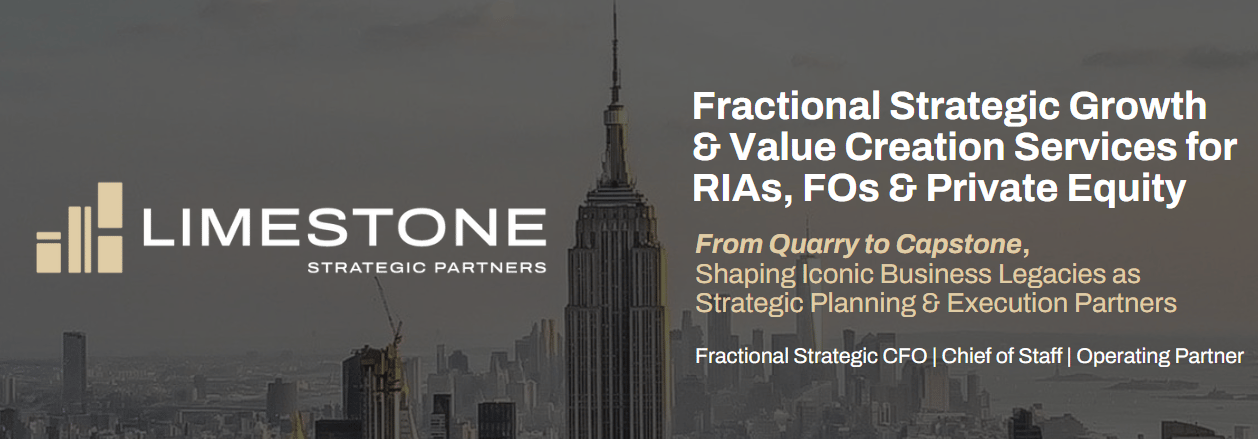- Building Iconic RIAs
- Posts
- Blueprint Bolt | 3.2.25 — Fiscal Clarity
Blueprint Bolt | 3.2.25 — Fiscal Clarity
Blueprint Bolt Weekly #4: Steer your RIA’s growth with a financial roadmap
The Market’s Been Good To Us. Maybe Too Good?
For the last 15 years, RIAs have had major winds at their backs. Market returns have driven somewhere north of 70% of new revenue, according to industry analysis. You didn’t have to work that hard to grow. Clients saw their portfolios climb with the S&P 500’s steady rise, AUM swelled, and fee-based revenue followed suit. Everyone’s happy—clients, advisors, and firm owners alike.
The Goldilocks market tailwinds we’ve had could be fading.
Asset prices are stretched (peak the Buffett Indicator), higher interest rates are settling into a new cycle, and industry organic growth is stuck at 2-4%. Firms that haven’t been proactively focused on organic growth and building businesses instead of just managing assets will hit a shock realization: the easy growth is gone, and they might even be shrinking.
Based on industry data I’ve seen, I would estimate 10% of RIAs account for 90% of the industry’s organic growth, think Pareto’s 80/20 rule but even more extreme. The rest are primarily coasting on market gains and client referrals here and there, betting the bull run won’t end.
What separates these cohorts of firms, the top growers from the stagnant majority? The fast-growing minority rely on a deliberate plan, not just vague ideas or rough sketches. Central to this, and the focus of today’s article, is their use of a fully functional financial model, mapping operational details to create a clear view of future financial outcomes and execute their strategy.
Most RIAs either skip this or only do it at the surface level. They aren’t deliberate about all it takes to drive the growth and scale they want, leaving them unprepared when a market slowdown stalls their progress.
Let’s unpack why a financial model fuels your firm’s growth and how to design one that steers your business into the future.
A Financial Model Isn’t Just a Revenue Forecast
Most advisors hear “financial model” and picture a spreadsheet predicting revenue and profit five years out. That’s part of it, but it misses the bigger picture.
A financial model is a dynamic decision-making tool that bridges how your firm operates today with where you want it to go tomorrow and beyond. It’s not a top-down guess based on last year’s numbers and some growth rate. The better way—a build-up method—starts from the details of your business: staff, clients, fees, everything. That’s what ties into the gap we’ve been talking about, moving from just managing assets to running a firm for the long haul.
It takes more time and effort than a quick top-down run, no question. But that’s why it pays off. You get into the weeds with questions like:
Can we afford to invest in future talent next year without straining cash flow?
What happens to margins if we shift from AUM-based fees to flat planning fees?
How many clients can our current staff support before service quality dips?
What’s our cash runway if the market drops 20% and fee revenue takes a hit?
How does launching a new service—like tax planning—impact profitability long-term?
The goal isn’t perfect forecasts—no model gets it all right, and that’s not the point. It’s about clarity and visibility: knowing what drives your RIA, seeing the full lay of the land, and making choices with real data, not hunches. Do it this way, and it’s a tool you use, not just something you glance at.
Beyond Numbers: Operational Insight
With that model in place, it’s your operational playbook, expressed through financial figures. It breaks down income—advisory fees, planning fees by client segment—against expenses like salaries, tech, marketing. Each piece intertwines, and you can see the impact of every move, not just the first step but the second-derivative stuff too—like how a new hire today affects client capacity and then profitability later.
It’s also your guardrail with scenario analysis. Run different what-ifs—say, a market dip or a fee shift—and you’ll catch where revenue or costs might slide before it’s a problem. For RIAs, where AUM rides the market’s ups and downs, this kind of heads-up is a must.
Then there’s tracking KPIs to keep you on point. Look at revenue per employee, net new assets, clients per advisor, margins—benchmark those against industry standards to see where you stand. If AUM’s up 8% but net new assets are flat, you’re leaning on markets, not growing on your own. That’s how you stay focused on what counts.
What Should a Financial Model Cover?
If you want a model that’s actually useful, it needs to connect operations and finance.
At a minimum, cover these:
✅ AUM Growth Forecasts – Inflows, outflows, and market returns
✅ Revenue Projections – Advisory fees, planning fees, and other revenue streams
✅ Expense Forecasts – Salaries, marketing, compliance, software, rent
✅ Cash Flow Projections – When and how money moves in and out
✅ Hiring Plans – When you need new advisors and staff, based on client growth
✅ Profitability Metrics – Revenue per advisor, margins, overhead
✅ Scenario Planning – Base case, best case, worst case
But if you want to take it a step further, add:
✅ Compensation Planning – Advisor pay, profit-sharing, and incentives
✅ Equity & Succession Strategy – Future ownership structure and dilution
✅ Capital Expenditures – Future office space additions, tech projects, acquisitions
✅ Client Segmentation – Which client types are actually profitable
✅ Advisor & Platform Team Makeup – Seniority and experience levels of your team
Not everything has to fit in one big model. You can split it into separate pieces, like a hiring plan or revenue breakdown, that feed into your main financial model. Just make sure you see how it all connects. That’s what makes the build-up approach worth it.
How a Financial Model Drives Your RIA’s Growth
Without a financial model, you’re likely reacting instead of steering your business forward. The top firms use it to make decisions in real time, turning data into action. Here’s how it works in practice:
1. Hiring on Time, Not Too Late
Many RIAs wait too long to hire. By the time they bring someone in, they’re already stretched thin, service is slipping, and growth slows down.
A model fixes that.
Example: Say you’re growing by $150M in AUM per year. It’s not just adding an advisor for every $150M. Your model figures out if you need a client service rep to handle the load or a platform staffer for tech support, telling you when to hire so you’re ahead, not scrambling.
2. Prioritizing Profitable Growth
A financial model sharpens your focus on what drives real value, not just what looks good on paper.
Example: You might assume ultra-high-net-worth clients are your top earners. But modeling profitability by segment could show mass-affluent clients bring in more per hour, guiding where to double down and where to pull back.
3. Planning for Market Cycles
Most firms are only planning for one future. The smart ones plan for three.
A proper model includes at the very least:
Base Case – Business grows at historical averages
Bull Case – Faster client acquisition, strong market performance
Bear Case – Market pullback, client attrition, slower new business
When the market drops 15%, do you cut costs, push harder on growth, or raise fees? A model tells you before it happens.
4. Making Capital and M&A Moves with Confidence
If you’re thinking about selling your firm, acquiring a practice, or raising capital, a financial model isn’t optional.
Banks, investors, and buyers don’t just care about your revenue. They care about how well you understand your business. A strong model helps you:
Understand your valuation
Show profitability under different scenarios
Prove you have a scalable model.
Firms with models land better deal terms because they’ve got concrete answers, not just guesses.
5. Compensation That Actually Makes Sense
Most RIAs aren’t as intentional about their advisor pay structure as they should be, especially with talent getting harder to acquire these days.
Your financial model should sort out a comp plan that lands top people and keeps your financials sustainable. It can figure out how to work in more firm equity—advisors are pushing for it—while making sure profits and growth hold up.
Ask yourself:
What happens to margins if we shift from a revenue split to salary + profit share?
Can we afford to offer equity without hurting cash flow to reinvest back in the business?
If we increase new business incentive compensation, how will it affect our financials?
Modeling compensation lets you discuss it with your team and clarify how it supports the firm’s overall health. This becomes even more critical when equity owners expect a clear view of the business’s performance.
How to Build a Model That Actually Helps You Scale
1. Use Good Data
Your CRM, accounting software, and operational data should feed into your model. Bad inputs = bad outputs. Reliable data uncovers the hidden patterns in your firm’s operations, not just the surface-level numbers.
2. Update It Quarterly
If your model is more than six months old, it means you likely aren’t using it in the way that it can truly add value. Adjust it with actual results and refine assumptions regularly. Frequent updates expose how shifts in your business or market impact your trajectory, not just where you stood last year.
3. Build It from the Bottom Up
Don’t just project revenue. Layer in hiring, expenses, and client growth to see how it all connects. This detailed approach reveals the cause-and-effect relationships driving your firm’s performance, not just the end results.
4. Keep It Flexible
Your assumptions will change. Make it easy to tweak variables and run different scenarios without breaking everything. Adaptability highlights how small adjustments today shape your firm’s outcomes tomorrow, not just a rigid forecast.
5. Get the Team Involved
Engage leadership across the firm to refine areas of the model they touch, ensuring accuracy and forward planning, especially for annual budgeting. They don’t need the full model, just its relevance. Cover it in leadership meetings. Collaboration clarifies how each leader’s decisions ripple through the firm’s finances, not just their isolated contributions.
Bottom Line: The Best RIAs Are Doing This. Are You?
RIAs scaling in 2025 aren’t leaving growth to chance. They use financial models to manage hiring, pricing, client expansion, and market shifts effectively. Firms that plan forward grow faster and handle downturns better.
Without a model, RIAs risk stagnation or setbacks when markets soften. Adopt a proactive business-owner mindset, ready for what’s ahead. Build the model, update it, use it. The firms thriving today already rely on this approach. Will you?

Top of mind content I’ve come across this week related to building and growing your own iconic RIA.
Article Recap: This Citywire CEO Summit recap article explores the surging popularity of private market funds aimed at wealthy individuals, delving into debates among industry leaders about distinguishing top managers, weighing evergreen funds' liquidity against potential return trade-offs, and scrutinizing continuation funds' ethics versus utility. It drives home the critical need for specialization, robust advisor guidance, and diversified portfolios to manage risks and capitalize on opportunities, warning that without proper education and diligence, clients risk falling prey to overhyped or unsuitable investments amid weakening standards.
My Thoughts on Article: This article, paired with its video interviews, does an excellent job of pushing advisors to consider how asset management execs view private markets targeting the high-net-worth (HNW) channel. I’m all in for more private market exposure in the HNW space. It’s a game-changer for diversification and still offers higher returns than public markets, but I can’t shake the feeling that we’re at a cycle point where institutions might be stepping back, letting retail investors pile in at less-than-ideal times. Education is desperately needed here, not just for clients but especially for advisors and gatekeepers, so they fully grasp what they’re getting their clients into and build the comfort and confidence, both for themselves and their clients, needed to drive broader adoption of these complex investments.
Private markets are slowly being democratized, much like public markets were, which means expected returns are likely to dip as access widens. They’re not the exclusive, hard-to-reach asset classes they were 20 to 30 years ago. As an advisor, you’ve got to approach this with that lens, balancing the promise of higher returns and diversification against the reality of a crowded field. Everyone and their mother is launching funds for HNW investors, often in semi-liquid structures like interval funds, and the jury’s still out on how these will hold up, especially with so many uneducated advisors and end investors jumping in without truly understanding the implications of locked-up capital. The article’s point about liquidity mismatches, like those redemption crunches in real estate funds, really hits home here.
That said, I still see huge value and opportunity in niche, boutique, and emerging managers in the private space. They can offer something unique and potentially outperform. But these aren’t as easy to access as the plug-and-play interval funds that have simplified entry. The big players, think titans like Blackstone, Apollo, Carlyle, will keep delivering solid returns because they’re damn good at what they do, just as the CEOs noted about firms with proven track records. But at a certain scale, managing tens of billions, it’s tough to generate the outsized returns they once did. Buffett’s said it forever: he can’t match the returns from his early days when he was a fraction of his current size, and the same logic applies to today’s private equity “asset managers.” Are they turning into asset gatherers? The jury’s out on that, and I’ll hold off on calling it, but the article’s warning about overhyped products and the need for specialization definitely makes you wonder.
Article Recap: Matt Crowe, CEO of Mercer Capital, warns that the RIA sector faces a potential stagflation threat in 2025, reminiscent of the Carter era, driven by stubbornly high inflation, economic stagnation, and rising interest rates, which could severely strain firms, especially those with acquisition debt. The takeaway is a call to action for RIA leaders to stress-test their financial resilience against these combined headwinds—higher borrowing costs, market downturns, and inflating labor expenses—to avoid being caught unprepared if stagflation materializes.
My Thoughts on Article: This article couldn’t be more timely, especially as we’re digging into financial modeling this week, particularly scenarios with less-than-ideal market return assumptions like stagflation. It’s a topic no one in the industry seems eager to touch, which is why I’m not surprised Matt Crowe and the Mercer Capital crew are the ones stepping up. Crowe’s advice hits the nail on the head. Here’s his exact wording: “If you haven’t already (I imagine many of you have), this is an excellent time to stress-test your financial condition to see what impact weakened markets, higher inflation, and rising interest rates will have on your firm.” Spot-on and prudent. We can’t predict the future, but we’ve been spoiled by a near-perfect market environment for wealth management, an absolute holy grail run. Now’s the time to shift gears and consider what could go wrong so we’re not blindsided if it does.
I see some big trends shifting. If we’re truly heading toward an “America First” policy, bringing manufacturing and investment back stateside while tightening immigration, that’s a recipe for inflation to heat up. Pair that with U.S. market valuations already stretched thin (just look at the Buffett Indicator screaming overvaluation, with Buffett himself sitting on a record cash pile), and it’s tough to imagine things getting much rosier. At best, we hope they don’t crater. The trifecta Crowe warns about, higher long-term rates, a market valuation reset, and wage inflation picking up steam, feels like a real possibility. The Trump administration might push for lower rates in the short term, and they could get their wish this year, but their broader policy playbook points to inflationary pressures down the road that could make this trifecta a reality.
Trying to predict exactly when or how this plays out is a fool’s game. Crowe’s right to frame it as a risk to model, not a certainty to bet on. But preparing for whatever comes? That’s something every firm can and should do. This article cuts through the industry hype, the nonstop cheerleading about how the party’s never-ending, and offers a sobering reset. The good times won’t last forever. We just don’t know when they’ll fade. Staying vigilant is the smart move. Definitely give it a read to ground yourself amid all the hoopla about perpetual good vibes in wealth management. Crowe’s call to stress-test for stagflation isn’t fearmongering. It’s a practical wake-up call.
Article Recap: John Furey, managing partner of Advisor Growth Strategies, warns that mid-sized RIAs must adopt robust process and accountability systems, like those of mega-firms, to achieve sustainable organic growth of 7-10% and withstand economic downturns. He emphasizes the importance of variable compensation, early equity distribution, and flexible cost models, cautioning that without these, firms risk being outpaced by larger, concentrated competitors controlling 60% of RIA assets—a share he predicts will hit 75% in five years.
My Thoughts on Article: I absolutely LOVE this article. It nails what truly separates the enterprise-level RIAs from the rest of the pack, and it all comes down to accountability systems and processes. Furey hits the mark perfectly by tying accountability to variable compensation—and not just for advisors, but for the whole team. I love how he highlights Brighton Jones, which I see as an industry icon. RIAs looking to scale should absolutely take notes from them. They’ve grown organically, been incredibly intentional about building great career paths (including equity ownership), and created an experience that really resonates with clients. They’ve got it figured out. What’s crazy is they’re so open about their approach—sharing tons of insights on industry podcasts. I’ve learned so much from studying how they’ve built their business, and I highly encourage you to do the same.
Furey also calls out much of the industry for being reactive and flying blind, which is exactly the point we’re driving home in our article of the week. You have to be intentional about managing, tracking, and projecting your business forward. This article sums up where the RIA industry stands today and shows there’s significant opportunity for others to hop on the growth train—if they shift to a mindset of accountability backed by solid processes and procedures.
Podcast Recap: Allen and Jacqueline, along with guest Brooks Hamner from Mercer Capital, warn that RIA valuations hinge more on controllable factors like revenue mix, operating expenses, and retained owner compensation than on simplistic multiples of AUM or revenue, which can mislead sellers. Their key takeaway is that maximizing valuation requires aligning your firm’s EBITDA (typically 30-50% margins) with buyer expectations, ensuring sustainable growth and infrastructure, and understanding deal terms—cash, equity, and retention payments—to avoid over-relying on inflated headline multiples that obscure realistic outcomes.
My Thoughts on Podcast: This 1.5-hour exploration of RIA valuations and M&A, with Mercer Capital joining for half, is exactly the type of stuff I like to keep up with—and it still surprised me with fresh insights. For RIA owners nearing a sale or succession, it’s a goldmine of practical guidance to maximize your valuation and dodge common traps. Even if you’re not there yet, it’s a crisp way to map the landscape. Absolutely worth your time.
I was hooked by their sharp take on those eye-popping EBITDA multiples the industry loves to tout—ones that likely aren’t the most realistic. They cut through RIA M&A jargon, dissecting deal mechanics with clarity that’s pure gold for anyone decoding the buzzwords. The depth is impressive, too much for me to cover individually, so carve out time to listen. You’ll thank me later.
Podcast Recap: Matt Reiner, podcast host, warns that building a firm that can scale and withstand challenges demands a strategic approach, blending structured processes and specialized team alignment, as discussed with Eric Sheeran of Dogwood Wealth. His main takeaways emphasize using systems like the Entrepreneurial Operating System (EOS) to ensure accountability, positioning the right people in tailored roles to boost efficiency and growth, and adopting flexible, forward-thinking planning to meet shifting client expectations and industry dynamics, all critical for sustainable expansion and resilience.
My Thoughts on Podcast:
I thought this episode offered a compelling real-life case study of a firm that’s grown to $250 million in assets under management (AUM) after breaking away from the wirehouse space, with its sights set on reaching $1 billion in the next 3 to 5 years. It’s the kind of story that could really resonate with current RIA owners and leaders who are running firms and looking to push to that next level. The mindset Dogwood Wealth is cultivating feels relatable and inspiring for anyone in that position.
I’m a huge fan of business operating systems, especially EOS, and I think it’s exactly what lower-middle-market firms should adopt as they figure out how to grow as a business, build a cohesive team, and work together to scale effectively. Eric gives us a practical, real-life perspective on how he and his firm apply EOS every day. While he doesn’t dive super deep into the nitty-gritty details, he shares enough to spark ideas about how you might run your own firm to reach that next milestone.
One thing that stood out was his focus on getting the right people on the bus and empowering your team to call you out and share their thoughts, something I fully embrace. Eric talks through how his team collaborates to tackle problems, and I absolutely love that he admits his firm used to say they were on track to hit their quarterly goals (or “rocks” in EOS lingo), only to find at the end of the quarter that they weren’t done. I’ve seen that exact issue at my previous firm, where we’d talk a good game about progress but fall short on execution. It’s a wake-up call that you have to hold each other accountable to see real action, not just say you’re taking action. That hit me hard because it’s likely the most common problem when it comes to achieving the plans you put together. It’s not just about planning, and it’s not just about action, it’s both working hand in hand.
Overall, this episode got me thinking about how firm leaders can blend structure and teamwork to drive growth. It’s not a step-by-step playbook, but it’s a solid nudge to reflect on your own approach and what it takes to level up.

Your Partner in Building Your Iconic RIA
Thanks for reading along!
Building an iconic RIA takes more than just insight—it requires a trusted partner to turn vision into reality. At LIMESTONE Strategic Partners, we’re here to help you unlock growth opportunities and maximize value. Our team is dedicated to scaling your practice into a thriving enterprise through fractional strategic planning and execution support. From financial strategy to operational excellence, we provide the support you need to achieve your goals.
Ready to take the next step? Visit limestonesp.com and schedule a free consultation. Let’s work together to build your iconic RIA.
-Jared
Jared Luegers, CFA, CEPA, Founder, LIMESTONE Strategic Partners



